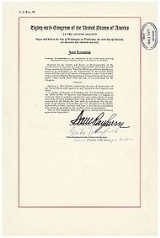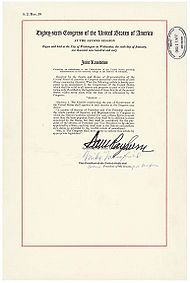
Twenty-third Amendment to the United States Constitution
Encyclopedia
The Twenty-third Amendment (Amendment XXIII) to the United States Constitution
permits citizens in the District of Columbia to vote for Electors for President and Vice President. The amendment was proposed by Congress on June 17, 1960, and ratified by the states on March 29, 1961. The first Presidential election in which it was in effect was the presidential election of 1964
.
Prior to the passage of the amendment, residents of Washington, D.C. were unable to vote for President or Vice President as the District is not a U.S. state
. They are still unable to send voting Representatives
or Senators
to Congress.
The amendment restricts the district to the number of Electors of the least populous state, irrespective of its own population. As of 2010, that state is Wyoming
, which has three Electors. However, even without this clause, the district's present population would only entitle it to three Electors.
Since the passage of this amendment, the District's electoral votes have gone towards the Democratic
candidates in every presidential election.
 Congress proposed the Twenty-third Amendment on June 17, 1960. The following states ratified the amendment:
Congress proposed the Twenty-third Amendment on June 17, 1960. The following states ratified the amendment:
The New Hampshire ratification was somewhat irregular; a vote for ratification was taken on the 29th, but was immediately rescinded. Another vote was taken on the 30th to ratify the amendment.
The amendment was rejected by the following state:
The following states have not ratified the amendment:
, which proposed to give the District full representation in the United States Congress, full representation in the Electoral College system, and full participation in the process by which the U.S. Constitution is amended. The amendment (as a resolution) was passed by Congress on August 22, 1978, but failed to be ratified by the required 38 states prior to its expiration on August 22, 1985.
United States Constitution
The Constitution of the United States is the supreme law of the United States of America. It is the framework for the organization of the United States government and for the relationship of the federal government with the states, citizens, and all people within the United States.The first three...
permits citizens in the District of Columbia to vote for Electors for President and Vice President. The amendment was proposed by Congress on June 17, 1960, and ratified by the states on March 29, 1961. The first Presidential election in which it was in effect was the presidential election of 1964
United States presidential election, 1964
The United States presidential election of 1964 was held on November 3, 1964. Incumbent President Lyndon B. Johnson had come to office less than a year earlier following the assassination of his predecessor, John F. Kennedy. Johnson, who had successfully associated himself with Kennedy's...
.
Prior to the passage of the amendment, residents of Washington, D.C. were unable to vote for President or Vice President as the District is not a U.S. state
U.S. state
A U.S. state is any one of the 50 federated states of the United States of America that share sovereignty with the federal government. Because of this shared sovereignty, an American is a citizen both of the federal entity and of his or her state of domicile. Four states use the official title of...
. They are still unable to send voting Representatives
United States House of Representatives
The United States House of Representatives is one of the two Houses of the United States Congress, the bicameral legislature which also includes the Senate.The composition and powers of the House are established in Article One of the Constitution...
or Senators
United States Senate
The United States Senate is the upper house of the bicameral legislature of the United States, and together with the United States House of Representatives comprises the United States Congress. The composition and powers of the Senate are established in Article One of the U.S. Constitution. Each...
to Congress.
The amendment restricts the district to the number of Electors of the least populous state, irrespective of its own population. As of 2010, that state is Wyoming
Wyoming
Wyoming is a state in the mountain region of the Western United States. The western two thirds of the state is covered mostly with the mountain ranges and rangelands in the foothills of the Eastern Rocky Mountains, while the eastern third of the state is high elevation prairie known as the High...
, which has three Electors. However, even without this clause, the district's present population would only entitle it to three Electors.
Since the passage of this amendment, the District's electoral votes have gone towards the Democratic
Democratic Party (United States)
The Democratic Party is one of two major contemporary political parties in the United States, along with the Republican Party. The party's socially liberal and progressive platform is largely considered center-left in the U.S. political spectrum. The party has the lengthiest record of continuous...
candidates in every presidential election.
Text
Proposal and ratification

- Hawaii (June 23, 1960)
- Massachusetts (August 22, 1960)
- New Jersey (December 19, 1960)
- New York (January 17, 1961)
- California (January 19, 1961)
- Oregon (January 27, 1961)
- Maryland (January 30, 1961)
- Idaho (January 31, 1961)
- Maine (January 31, 1961)
- Minnesota (January 31, 1961)
- New Mexico (February 1, 1961)
- Nevada (February 2, 1961)
- Montana (February 6, 1961)
- South Dakota (February 6, 1961)
- Colorado (February 8, 1961)
- Washington (February 9, 1961)
- West Virginia (February 9, 1961)
- Alaska (February 10, 1961)
- Wyoming (February 13, 1961)
- Delaware (February 20, 1961)
- Utah (February 21, 1961)
- Wisconsin (February 21, 1961)
- Pennsylvania (February 28, 1961)
- Indiana (March 3, 1961)
- North Dakota (March 3, 1961)
- Tennessee (March 6, 1961)
- Michigan (March 8, 1961)
- Connecticut (March 9, 1961)
- Arizona (March 10, 1961)
- Illinois (March 14, 1961)
- Nebraska (March 15, 1961)
- Vermont (March 15, 1961)
- Iowa (March 16, 1961)
- Missouri (March 20, 1961)
- Oklahoma (March 21, 1961)
- Rhode Island (March 22, 1961)
- Kansas (March 29, 1961)
- Ohio (March 29, 1961)
- Ratification was completed on March 29, 1961. The amendment was subsequently ratified by the following states:
- New Hampshire (March 30, 1961)
- Alabama (April 16, 2002)
The New Hampshire ratification was somewhat irregular; a vote for ratification was taken on the 29th, but was immediately rescinded. Another vote was taken on the 30th to ratify the amendment.
The amendment was rejected by the following state:
- Arkansas (January 24, 1961)
The following states have not ratified the amendment:
- Florida
- Kentucky
- Mississippi
- Georgia
- South Carolina
- Louisiana
- Texas
- North Carolina
- Virginia
Proposed repeal
The 23rd Amendment would have been repealed by the District of Columbia Voting Rights AmendmentDistrict of Columbia Voting Rights Amendment
The District of Columbia Voting Rights Amendment was a proposed amendment to the United States Constitution that would have given the District of Columbia full representation in the United States Congress, full representation in the Electoral College system, and full participation in the process by...
, which proposed to give the District full representation in the United States Congress, full representation in the Electoral College system, and full participation in the process by which the U.S. Constitution is amended. The amendment (as a resolution) was passed by Congress on August 22, 1978, but failed to be ratified by the required 38 states prior to its expiration on August 22, 1985.
See also
- District of Columbia statehood movementDistrict of Columbia statehood movementThe District of Columbia statehood movement is a political movement that advocates making the District of Columbia a U.S. state. Statehood would give the citizens of Washington, D.C. full representation in the United States Congress and full control over their own local affairs.Full statehood for D.C...
- District of Columbia voting rightsDistrict of Columbia voting rightsVoting rights of citizens in the District of Columbia differ from those of United States citizens in each of the fifty states. District of Columbia residents do not have voting representation in the United States Senate, but D.C. is entitled to three electoral votes for President. In the U.S...
- District of Columbia retrocession

